Meta Description: Master cockroach extermination with our complete guide. Learn to identify signs of an infestation, use effective home remedies, and know when to call a professional for total eradication.
Introduction to Cockroach Extermination
Cockroach infestations present a significant challenge for homeowners, threatening hygiene and public health. Successful cockroach extermination begins with understanding these resilient pests. Driven by their need for food, water, and shelter, cockroaches can invade even the most well-kept homes. This comprehensive guide details their nature, the harm they cause, and how to identify an infestation. We will explore a range of solutions, from natural home remedies to professional interventions, to help you achieve a pest-free environment.
Understanding Cockroaches
Cockroaches are ancient insects with an exceptional ability to adapt and survive. People often find them challenging to eliminate because their oily exoskeletons allow them to slip into the narrowest crevices.
The Cockroach Life Cycle
A cockroach’s life cycle involves three stages: egg, nymph, and adult. Females produce egg capsules, called oothecae, which can contain dozens of eggs. After hatching, nymphs, which look like smaller, wingless adults, molt several times before reaching maturity over two to three months.
Common Household Species
Among thousands of species, a few are particularly troublesome in homes:
- German Cockroach: The most common indoor species, it reproduces quickly, making cockroach extermination particularly difficult. You will frequently find them in kitchens and bathrooms.
- American Cockroach: The largest species in North America, this reddish, shiny pest often lives in sewer systems and enters through lower-level city apartments.
- Brown-banded Cockroach: This smaller pest often hides in drier, higher areas of rooms and doesn’t require high moisture to thrive.
Why Cockroaches Are Harmful to Humans
Beyond being a nuisance, cockroaches pose significant health risks. They can transfer a wide range of disease-causing microorganisms from unsanitary areas to your food and kitchen surfaces.
Disease Transmission
Cockroaches can spread bacteria and viruses responsible for diseases such as:
- Cholera
- Dysentery
- Salmonellosis
- E. Coli
- Typhoid Fever
- Listeria
Ingested bacteria can survive in a cockroach’s digestive system and spread through its droppings. The pests also regurgitate and defecate on food, causing further contamination.
Allergies and Asthma
Furthermore, cockroach debris, including feces and shed skins, is a known allergen. This debris can trigger allergic reactions and asthma attacks in sensitive individuals. Research shows that suppressing cockroach populations reduces the proteins that cause these allergic reactions.
Signs of a Cockroach Infestation
Detecting an infestation early is critical for effective cockroach extermination. Look for these key indicators:
- Visible Sightings: Seeing cockroaches during the day suggests a significant infestation, as overcrowding may force them from their hiding spots.
- Egg Capsules (Oothecae): Finding these oval, dark brown cases confirms breeding activity.
- Cockroach Droppings: These droppings look like black dust or coffee grounds.
- Unusual Odor: A distinct musty or oily smell is characteristic of a roach infestation.
- Shed Skins: As they mature, cockroaches shed their exoskeletons, leaving them behind as a sign of their presence.
- Smear Marks: In humid areas, cockroaches leave horizontal brown smear marks.
- Damage: Unexplained damage to food packaging, leather, or cardboard can point to cockroach activity.
Where Do Cockroaches Live in Homes?
Cockroaches thrive where they can easily find food, water, and shelter. Knowing their hiding spots is a key part of any cockroach extermination plan.
Common Indoor Hiding Spots
These pests gravitate towards warm, dark, and moist environments. Kitchens and bathrooms are prime targets, so check these areas:
- In cabinets, especially under sinks.
- Inside or underneath garbage cans.
- Behind and under appliances like stoves and refrigerators.
- Within cracks and crevices in walls and baseboards.
- In drains, grease traps, and around leaky pipes.
- In laundry rooms and cellars.
Common Outdoor Hiding Spots
Outdoors, look for cockroaches in damp, concealed areas:
- Under decks and in crawl spaces.
- Near plumbing and sewer leaks.
- In brush, leaf litter, and mulch.
- Inside storage sheds and around dumpsters.
Prevention: The First Step in Cockroach Control
Prevention is paramount to effective cockroach control. Keeping them out is far easier than eliminating an established infestation.
- Maintain Rigorous Sanitation: Clean all surfaces regularly, especially in the kitchen. Promptly clean up spills and store all food in airtight containers. Do not leave dirty dishes in the sink overnight.
- Eliminate Moisture Sources: Cockroaches need water to survive. Repair any leaky faucets or pipes to cut off their supply.
- Seal Entry Points: Inspect and seal any holes or cracks in walls, cupboards, and around plumbing. Ensure windows and doors have well-maintained screens.
- Manage Your Outdoor Environment: Keep vegetation, mulch, and wood piles clear from your home’s foundation.
- Inspect Incoming Items: Check groceries, boxes, and secondhand furniture for hidden cockroaches or egg capsules before bringing them inside.
- Reduce Clutter: Eliminate potential hiding spots by decluttering your home and garage. Roaches love to hide in piles of paper and cardboard.
Effective Home Remedies for Cockroach Control
For minor infestations, various home remedies can offer a safer alternative to harsh chemicals. However, their effectiveness for complete cockroach extermination on a large scale is often limited.
Baits and Powders
- Boric Acid: Many consider boric acid one of the most effective remedies. It acts as a stomach poison when ingested. Apply a thin, barely visible layer in dry corners, but keep this poison away from children and pets.
- Baking Soda and Sugar: This classic method uses sugar to attract cockroaches and baking soda to kill them. Sprinkle an equal-parts mixture in known hideouts.
- Diatomaceous Earth (DE): This food-grade powder damages the cockroach’s exoskeleton, causing dehydration. Dust a thin layer in dry areas where you see activity.
Natural Repellents and Sprays
- Neem: You can use diluted neem oil as a spray or sprinkle neem powder in infested areas.
- Peppermint Oil: This essential oil acts as a natural repellent. Mix it with water and spray in infested areas to deter roaches.
- Fabric Softener Spray: A mixture of fabric softener and water can kill a cockroach on contact by suffocating it.
- Vinegar: A solution of white vinegar and water works as a cleaning agent and a deterrent, though it won’t kill cockroaches directly.
- Catnip: The active compound in catnip is a natural cockroach repellent. Use it as a tea spray or in sachets, but avoid this method if you have cats.
Traps and Other Methods
- Glue Strips / Roach Motels: These traps lure and capture cockroaches, helping you monitor infestation levels and identify hotspots without pesticides.
- Alcohol Spray: Spraying isopropyl alcohol directly on visible roaches will kill them on contact.
When to Call a Professional for Cockroach Extermination
While home remedies can help, they are often insufficient for complete cockroach extermination. Spotting even one cockroach can signal a much larger, hidden problem that requires professional attention.
Advantages of Professional Services
- Expert Assessment: Professionals accurately identify the species and determine the full extent of the infestation.
- Potent Treatments: Exterminators use powerful, targeted treatments like insect growth regulators (IGRs) and professional-grade baits that are more effective for thorough elimination. A professional cockroach extermination plan often yields faster results.
- Addressing Root Causes: An expert can identify and seal entry points to prevent future invasions.
- Long-term Solutions: Professional services often include crucial follow-up treatments to ensure complete eradication.
- Safety: Exterminators receive training in proper application techniques to minimize risks to children and pets.
If home remedies fail or you face a persistent infestation, contacting a licensed pest control company is the most reliable path to a solution.
Safety Tips for Cockroach Control
When applying any method for cockroach extermination, you must prioritize safety:
- Ventilation: Always ensure adequate ventilation by opening windows to minimize inhaling fumes or dust.
- Personal Protection: Wear gloves and a mask when handling powders like boric acid or DE.
- Child and Pet Safety: Keep all remedies, especially poisons and baits, out of reach of children and pets.
- Hygiene: Wash your hands thoroughly with soap and water after handling any substances.
- Food Contact: Prevent remedies from touching kitchen counters, utensils, or food.
- Avoid Mixing Chemicals: Never mix different pesticides or cleaning agents, as this can create hazardous fumes.
Conclusion
An effective cockroach extermination strategy requires a multi-faceted approach that combines vigilant sanitation, strategic exclusion, and targeted treatment. While home remedies are useful for minor issues, persistent infestations demand the expertise of professional pest control services. By understanding cockroach behavior, implementing diligent prevention, and applying the right methods, you can win the battle against these unwelcome pests and maintain a healthier home.



